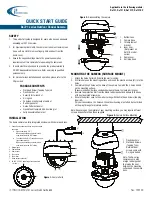
114
ķ
• The camera is equipped with a lens without CPU.
The aperture setting on the flash unit is not automatically adjusted to that
of the lens.
• The camera is not transmitting any digital data to the flash unit (Group A
cameras).
• There is no exchange of data between the flash unit and the camera. Tap
the camera’s shutter release.
• The camera is equipped with a lens without CPU.
The secondary reflector cannot be activated, or no flash is triggered.
• The secondary reflector does not support the stroboscopic, remote and
modelling light (ML) flash modes. In these modes the secondary reflector
cannot be activated, or the secondary reflector does not trigger a flash.
• The main reflector is in its normal position or tilted downwards.
The secondary reflector flashes even though it is switched off.
• The mecablitz operates as a master in the remote system. The secondary
reflector of the master flash unit controls the slave flash units. The light of
the secondary reflector does not contribute to the exposure of the shot in
this case.
The TTL fill-in flash
BL cannot be set.
• There has been no exchange of data between the flash unit and the
camera. Tap the camera’s shutter release.
• The camera does not support TTL fill-in flash mode.
• The camera is switched to spot metering. Choose another metering type,
for example multi-zone metering.
The setting for manual TTL flash exposure correction has no effect.
• The camera does not support manual TTL flash exposure correction on the
flash unit (Group A cameras, for example).
TTL
Flash unit cannot be set for wireless remote operation as the master flash
unit.
• Wireless remote operation is supported only by Group E cameras. Remote
flash operation is not available with other cameras.
• There has been no exchange of data between the flash unit and the
camera. Tap the camera’s shutter release.
Automatic switching to the flash sync speed fails to occur.
• The camera has a between-the-lens shutter (as do most compact cameras),
Switching to sync speed is therefore unnecessary.
• The camera operates with FP high-speed synchronisation (camera setting).
In this case no switching to sync speed occurs.
• The camera operates with shutter speeds that are slower than the flash
sync speed. Depending on the camera mode, there is no switch to flash
sync speed (see the camera’s operating instructions).
The shots have shadows in the bottom of the image.
• Because of parallax error between lens and flash unit, close-up shots may
not, depending on the focal length at the bottom of the image, be fully illu-
minated. Tilt the main reflector downwards or turn the wide-angle diffuser
in front of the reflector.
The shots are too dark.
• The subject is beyond the range of the flash unit. Note: Using bounce flash
reduces the range of the flash unit.
• The subject contains very bright or highly reflective areas. The metering
system of the camera or flash unit is deceived as a result. Set a positive
manual flash exposure correction, e.g., +1 EV.
The shots are too bright.
• In close-up shots, overexposure (shots that are too bright) may result if the
shutter speed is faster than the flash sync speed. The minimum distance
from the subject should be at least 10% of the maximum flash range indi-
cated on the display.
706 47 0029-A3 58 AF-1 N 30.05.2007 8:05 Uhr Seite 114
















































